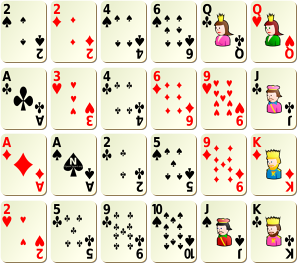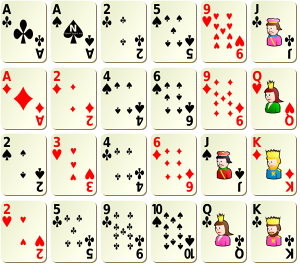Like good magic tricks, clever puzzles can inspire awe, reveal mathematical truths and prompt important questions. At least that is what Martin Gardner1 thought. His name is synonymous with the legendary Mathematical Games column he wrote for a quarter of a century in Scientific American2. The column that began in January 1957 has become a legend in publishing, even though it's been almost 30 years since the last one appeared. Thanks to his own mathemagical skills, Gardner presented noteworthy mathematics every month with all the wonder of legerdemain and — in so doing — captivated a huge readership worldwide. The columns are still considered models of clarity and elegance for introducing fresh and engaging ideas in mathematics in non-technical ways.

While many articles of the ever-prolific Martin Gardner fall under the umbrella of "recreational mathematics", others touched on cutting-edge concepts involving contributions from some of the world's most creative minds. Even the articles that seemed to be purely for entertainment sometimes inspired important research, some of which led to developments with real impact on science, technology and society. This success is all the more remarkable considering that Gardner had no formal training in mathematics. In his memoirs Undiluted Hocus-Pocus (Princeton, 2013), Gardner recalls:
One of the pleasures in writing the column was that it introduced me to so many top mathematicians, which of course I was not. Their contributions to my column were far superior to anything I could write, and were a major reason for the column's growing popularity. The secret of its success was a direct result of my ignorance. Even today my knowledge of math extends only through calculus, and even calculus I only dimly comprehend. As a result, I had to struggle to understand what I wrote, and this helped me write in ways that others could understand.
In this assignment we focus on a nice trick that appeared in one of the Mathematical Games columns that Martin Gardner wrote together with the mathematician Ross Honsberger3. Deal cards into any rectangular array:

Put the cards on each row of the array such that they are sorted in increasing order. In doing so, you only need to take into account the numerical value of the cards.

Now you do the same with the cards in each column of the array.

Surprisingly, that last step hasn't disturbed the preceding one — the cards in each row are still sorted in increasing order. Any idea how this is possible?
Assignment
The above trick works with all objects that can be sorted. In this assignment we keep it simple by considering only integers. This is exemplified using the following integer array. \[ \begin{array}{rrrrrr} 2 & 12 & 2 & 4 & 6 & 12\\ 9 & 11 & 3 & 4 & 1 & 6\\ 13 & 2 & 5 & 9 & 1 & 1\\ 13 & 2 & 5 & 10 & 11 & 9 \end{array} \,\, \stackrel{\text{sort rows}}{\longrightarrow} \,\, \begin{array}{rrrrrr} 2& 2& 4& 6& 12& 12\\ 1& 3& 4& 6& 9& 11 \\ 1& 1& 2& 5& 9& 13\\ 2& 5& 9& 10& 11& 13 \end{array} \,\, \stackrel{\text{sort columns}}{\longrightarrow} \,\, \begin{array}{rrrrrr} 1& 1& 2& 5& 9& 11 \\ 1& 2& 4& 6& 9& 12 \\ 2& 3& 4& 6& 11& 13 \\ 2& 5& 9& 10& 12& 13 \end{array} \]
Define a class Grid that can be used to represent rectangular arrays of integers. This class must support at least the following methods:
-
An initialization method that takes a single argument. In case a string is passed as an argument, it must contain the location of a text file from which a rectangular integer array can be read. Each line of the file must contain the integers on a single row of the array, separated from each other by one or more spaces or tabs. As an alternative, a list of tuple containing the rows of the array can be passed as an argument, where each row is itself represented as a list or tuple of the integers on that row. In either case, a rectangular integer array must be passed with at least one row and at least one column, for which holds that each row contains the same number of integers. If this is not the case, the method must raise an AssertionError with the message invalid grid.
-
A method largest that returns the largest integer in the array.
-
A method smallest that returns the smallest number in the array.
-
A method __str__ that returns a string representation of the array. Each integer in this string representation must be right aligned over $$p$$ positions, where $$p$$ is the number of characters needed to represent the widest integer in the array. The columns of the array must be separated by a single space in the string representation.
-
A method sorted having two optional parameters decreasing and columns that both take Boolean values (default value: False). The method must return a Boolean value that indicates whether or not the rows (columns = False) or columns (columns = True) are sorted in increasing (decreasing = False) or decreasing (decreasing = True) order.
-
A method sort having two optional parameters decreasing and columns that both take Boolean values (default value: False). The method must make sure that the integers on each row (columns = False) or column (columns = True) of the array are sorted in increasing (decreasing = False) or decreasing (decreasing = True) order. The method must return a reference to the object on which the method was called.
Make sure that the operator + (plus sign) can be used to compose two grids (objects of the class Grid) into a grid that is formed by putting the columns of the second grid after the columns of the first grid. The end result must be a new object of the class Grid. If the grids that are composed do not have the same number of rows, an AssertionError must be raised with the message different number of rows.
Make sure that the operator - (minus sign) can be used to compose two grids (objects of the class Grid) into a grid that is formed by putting the rows of the second grid underneath the rows of the first grid. The end result must be a new object of the class Grid. If the grids that are composed do not have the same number of columns, an AssertionError must be raised with the message different number of columns.
Example
In the following interactive session, we assume that the text file grid.txt4 is located in the current directory.
>>> grid = Grid('grid.txt')
>>> grid.largest()
16
>>> grid.smallest()
1
>>> print(grid)
16 3 2 13
5 10 11 8
9 6 7 12
4 15 14 1
>>> grid.sorted()
False
>>> grid.sorted(columns=True)
False
>>> print(grid.sort())
2 3 13 16
5 8 10 11
6 7 9 12
1 4 14 15
>>> grid.sorted()
True
>>> grid.sorted(columns=True)
False
>>> print(grid.sort(columns=True))
1 3 9 11
2 4 10 12
5 7 13 15
6 8 14 16
>>> grid.sorted()
True
>>> grid.sorted(columns=True)
True
>>> print(grid.sort(decreasing=True))
11 9 3 1
12 10 4 2
15 13 7 5
16 14 8 6
>>> grid.sorted()
False
>>> grid.sorted(decreasing=True)
True
>>> print(grid.sort(columns=True, decreasing=True))
16 14 8 6
15 13 7 5
12 10 4 2
11 9 3 1
>>> grid.sorted(columns=True)
False
>>> grid.sorted(columns=True, decreasing=True)
True
>>> row = Grid([[17, 18, 19, 20]])
>>> print(grid - row)
16 14 8 6
15 13 7 5
12 10 4 2
11 9 3 1
17 18 19 20
>>> col = Grid([[-21], [-22], [-23], [-24]])
>>> print(col + grid)
-21 16 14 8 6
-22 15 13 7 5
-23 12 10 4 2
-24 11 9 3 1
>>> print(grid - row)
16 14 8 6
15 13 7 5
12 10 4 2
11 9 3 1
17 18 19 20
>>> print(col + grid)
-21 16 14 8 6
-22 15 13 7 5
-23 12 10 4 2
-24 11 9 3 1
>>> Grid([[1], [2, 3], [4, 5, 6]])
Traceback (most recent call last):
AssertionError: invalid grid
>>> Grid([])
Traceback (most recent call last):
AssertionError: invalid grid
>>> Grid([[]])
Traceback (most recent call last):
AssertionError: invalid grid
>>> grid - col
Traceback (most recent call last):
AssertionError: different number of columns
>>> grid + row
Traceback (most recent call last):
AssertionError: different number of rows